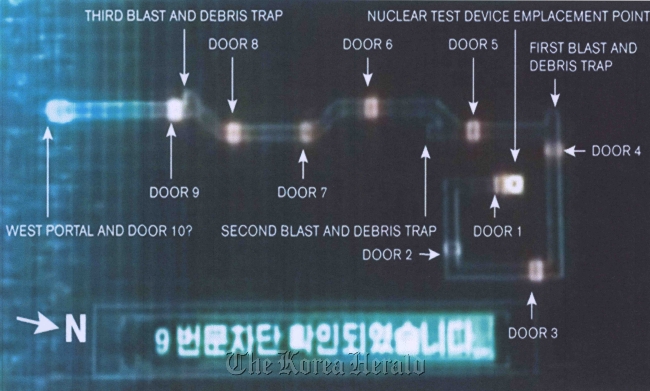Image shows inside of N.K. nuclear weapons test facility
By Korea HeraldPublished : Feb. 4, 2013 - 19:14

The Defense Ministry on Monday unveiled an image of the internal structure of an underground site in North Korea presumed to have been used for its second nuclear test in May 2009.
The image depicts a spiral-shaped horizontal tunnel with nine doors in the western part of the Punggye-ri test site in the country’s northeast, officials said. It was captured from a documentary film broadcast by the North’s Korean Central TV in September 2010.
Ministry officials said the image underscored a “strong, sophisticated” design much more advanced than the tunnel at the east of the Punggye-ri site, which was used in Pyongyang’s first atomic test in October 2006.
Officials said Pyongyang was likely to use a tunnel of the same type for its third nuclear test.
“The tunnel appears to be shorter than 1 km and it still remains unclear whether these doors ― designed to cushion the bombing shock ― are really doors or concreted structures. Space between the doors appears to be empty, but some could be filled,” a ministry official told reporters.
“In the first test, there were not many doors in the tunnel that could block radioactive gases from leaking out of the tunnel. But the tunnel for the second test was spiral-shaped and had many doors that helped block the gases from leaking.”
He added the first door in the photo was presumed to be a sliding door made of a three-tier steel structure.
In the photo, there are also three “debris traps” to prevent debris from forcefully hitting each door, officials explained. Mount Mantapsan, where the tunnels are located, is about 2,200 meters high, and its granite structure could melt down when the nuclear detonation occurs, they said.
The first tunnel in the east of the site was shut down following the 2006 test.
By Song Sang-ho (sshluck@heraldcorp.com)
The image depicts a spiral-shaped horizontal tunnel with nine doors in the western part of the Punggye-ri test site in the country’s northeast, officials said. It was captured from a documentary film broadcast by the North’s Korean Central TV in September 2010.
Ministry officials said the image underscored a “strong, sophisticated” design much more advanced than the tunnel at the east of the Punggye-ri site, which was used in Pyongyang’s first atomic test in October 2006.
Officials said Pyongyang was likely to use a tunnel of the same type for its third nuclear test.
“The tunnel appears to be shorter than 1 km and it still remains unclear whether these doors ― designed to cushion the bombing shock ― are really doors or concreted structures. Space between the doors appears to be empty, but some could be filled,” a ministry official told reporters.
“In the first test, there were not many doors in the tunnel that could block radioactive gases from leaking out of the tunnel. But the tunnel for the second test was spiral-shaped and had many doors that helped block the gases from leaking.”
He added the first door in the photo was presumed to be a sliding door made of a three-tier steel structure.
In the photo, there are also three “debris traps” to prevent debris from forcefully hitting each door, officials explained. Mount Mantapsan, where the tunnels are located, is about 2,200 meters high, and its granite structure could melt down when the nuclear detonation occurs, they said.
The first tunnel in the east of the site was shut down following the 2006 test.
By Song Sang-ho (sshluck@heraldcorp.com)
-
Articles by Korea Herald



![[Exclusive] Korean military set to ban iPhones over 'security' concerns](http://res.heraldm.com/phpwas/restmb_idxmake.php?idx=644&simg=/content/image/2024/04/23/20240423050599_0.jpg&u=20240423183955)




![[Pressure points] Leggings in public: Fashion statement or social faux pas?](http://res.heraldm.com/phpwas/restmb_idxmake.php?idx=644&simg=/content/image/2024/04/23/20240423050669_0.jpg&u=)

![[Herald Interview] 'Amid aging population, Korea to invite more young professionals from overseas'](http://res.heraldm.com/phpwas/restmb_idxmake.php?idx=644&simg=/content/image/2024/04/24/20240424050844_0.jpg&u=20240424200058)









